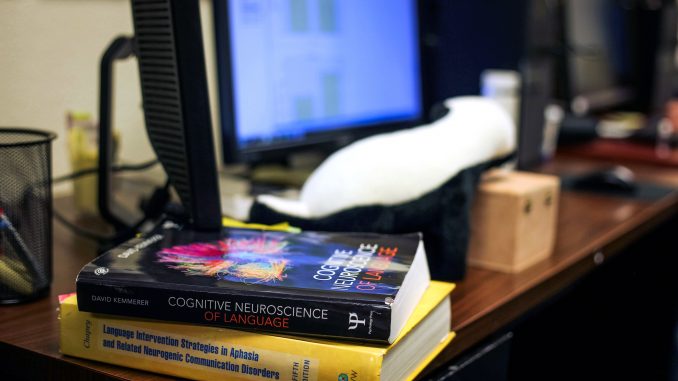
For someone dealing with semantic dementia, their definition of a swan as a ‘bird’ could change to ‘dog’ in just a matter of years.
This was seen in research conducted by Dr. John Hodges, a professor of neuroscience currently in Australia, and is one kind of case Temple’s Memory, Concepts, Cognition Laboratory studies on a daily basis.
The lab staff deals with language and neurological disorders and semantic memory, and it focuses on the social and behavioral aspects of the human body.
The small workspace is located in Ritter Annex 999, stocked with computers and other equipment. Lab Director Dr. Jamie Reilly opened the lab in January 2014 after he left his job as an assistant professor at the University of Florida. He worked at a similar lab there, studying language disorders and how to improve language in patients with Alzheimer’s, until he moved his research to Temple.

Reilly studied linguistics and Russian as an undergraduate and speech-language pathology for his clinical master’s degree. He went on to earn his Ph.D. in cognitive psychology at Temple, followed by a postdoctoral fellowship in cognitive neuroscience. His interests align with the lab’s: studying memory disorders and helping to treat them.
“I’m interested in both how the study of, say Alzheimer’s disease, adds to the theory of what we know about the brain but also in how to actually improve language in people,” said Reilly, associate professor and interim chair in the department of communication sciences and disorders. “So it’s a mix for me.”
The lab is mostly occupied by undergraduate volunteers, students doing independent research for senior projects, two master’s students and a dedicated staff. The two postdoctoral fellows of the lab, who often work the closest with Reilly, are Dr. Richard Binney and Dr. Jinyi Hung.
With Binney’s background in brain imaging and brain stimulation techniques and Hung’s experience with eye-tracking techniques and semantic processing, their work ranges from examining relationships between brain structure and function to pondering how meaning is processed in the brain.
“It’s a hard science, in some ways, but it’s also an area for philosophical ponderings about what it means to think, what meaning is and ask some questions about what it is to be human,” said Binney, who completed his Ph.D. in cognitive neuroscience at the University of Manchester.
Hung’s interest with these areas of study started with her consideration of her cultural background and how it plays a part in her kind of research into semantics.
“Coming from a different cultural background, I always think that the way I process meaning is sometimes a little bit different than what other cultures process meaning,” said Hung, a 2015 Ph.D. alumna from the University of Florida in speech, language and hearing sciences.

Thanks to a grant, Hung works with Reilly to go out and see patients regularly, all of whom deal with memory disorders, for research and clinical purposes. The tools the lab uses include MRI scanners, a transcranial direct current stimulator that provides one or two milliamp current stimuli to parts of the brain and an infrared eye-tracker.
Specifically with the eye-tracker, an infrared bar shoots infrared light that bounces off a retina and samples at a rate of 120 times per second to tell where a person’s eyes are moving by each millisecond. Reilly explained how this tool is used to see how a person with semantic dementia is unable to recall what a dog is when looking at a picture of one—for healthy people, our eyes look over the body and face of a dog to determine immediately what it is, but unhealthy patients’ eyes do not go where they should.
With the amount of work that needs to be done, Binney is thankful for the large and diverse population of undergraduate students who volunteer. Many of the students come from a course Reilly used to teach, “Language and the Brain,” which is now taught by Hung.
“We’ve been really fortunate to find lots of fantastic students who are going to, we hope to encourage, be the future generation of scientists,” Binney said.
As for that future of treating and preventing memory disorders, Reilly feels there is a long way to go.
“As a scientist, you can’t tackle the big questions—the tradition is you do it in a reductionist way, we take very small pieces,” he said. “The problems are so big that you could spend a lifetime looking at them. … For me, the number of questions just keep coming.”
Albert Hong can be reached at albert.hong@temple.edu.


Be the first to comment